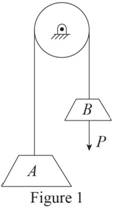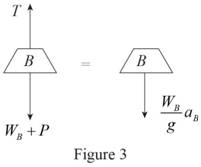
Concept explainers
(a)
Find the acceleration of block A for each system.
(a)
Answer to Problem 12.15P
The acceleration of block A for system 1 is
The acceleration of block A for system 2 is
The acceleration of block A for system 1 is
Explanation of Solution
Calculation:
Sketch the general diagram of systems as shown in Figure (1).

Write total length of cable connecting block A and block B.
Here,
Differentiate Equation (1) with respect to t to write velocity of the blocks.
Here,
Differentiate Equation (2) with respect to t to write acceleration of the blocks.
First of all check the required static friction with static friction to maintain equilibrium.
Sketch the free body diagram and kinetic diagram of block A as shown in Figure (2).

Refer Figure (2).
Consider downward direction as positive.
Apply Newton’s law of motion along y-axis.
Here, T is the tension in the cable,
Sketch the free body diagram and kinetic diagram of block B as shown in Figure (3).

Refer Figure (3).
Consider downward direction as positive.
Apply Newton’s law of motion along y-axis.
Find the equation of acceleration of block A.
Here, T is the tension in the cable,
Substitute
The initial velocity of block A is zero.
Find the equation of velocity of block A using kinematics:
Here,
Substitute At
Find the equation of time required for block A to reach any velocity.
Find the acceleration of block A
Substitute 200 lb for
Therefore, the acceleration of block A for system 1 is
Find the acceleration of block A
Substitute 200 lb for
Therefore, the acceleration of block A for system 2 is
Find the acceleration of block A
Substitute 2200 lb for
Therefore, the acceleration of block A for system 2 is
(b)
Find the velocity of block A for each system after it has moved through 10 ft
(b)
Answer to Problem 12.15P
The velocity of block A for system 1 after it has moved through 10 ft is
The velocity of block A for system 2 after it has moved through 10 ft is
The velocity of block A for system 3 after it has moved through 10 ft is
Explanation of Solution
Calculation:
Find the velocity of block A for system 1
Substitute
Thus, the velocity of block A for system 1 after it has moved through 10 ft is
Find the velocity of block A for system 2
Substitute
Thus, the velocity of block A for system 2 after it has moved through 10 ft is
Find the velocity of block A for system 3
Substitute
Thus, the velocity of block A for system 3 after it has moved through 10 ft is
(c)
Find the time required for block A to reach a velocity of 20 ft/s
(c)
Answer to Problem 12.15P
The time required for block A for system 1 to reach a velocity of 20 ft/s is
The time required for block A for system 2 to reach a velocity of 20 ft/s is
The time required for block A for system 3 to reach a velocity of 20 ft/s is
Explanation of Solution
Calculation:
Find the time required for block A for system 1
Substitute
Thus, the time of required for block A for system 1 to reach a velocity of 20 ft/s is
Find the time required for block A for system 2
Substitute
Thus, the time of required for block A for system 2 to reach a velocity of 20 ft/s is
Find the time required for block A for system 3
Substitute
Thus, the time of required for block A for system 3 to reach a velocity of 20 ft/s is
Want to see more full solutions like this?
Chapter 12 Solutions
Vector Mechanics for Engineers: Statics and Dynamics
- An advanced spatial disorientation trainer allows the cab to rotate around multiple axes as well as to extend inwards and outwards. It can be used to simulate driving, fixed-wing aircraft flying, and helicopter maneuvering. In one training scenario, the trainer rotates and translates in the horizontal plane where the location of the pilot is defined by the relationships where r,0, and t are expressed in feet, radians, and seconds, respectively. Knowing that the pilot has a weight of 175 lbs, (a) determine the magnitude of the resulting force acting on the pilot at t= 5 s, (b) plot the magnitudes of the radial and transverse components of the force exerted on the pilot from 0 to 10 seconds.arrow_forwardThe 3-kg collar B slides on the frictionless arm AA’. The arm is attached to drum D and rotates about O in a horizontal plane at the rate 0=0.75t, where 0 and t are expressed in rad/s and seconds, respectively. As the arm-drum assembly rotates, a mechanism within the drum releases cord so that the collar moves outward from O with a constant speed of 0.5 m/s. Knowing that at t= 0, r= 0, determine the time at which the tension in the cord is equal to the magnitude of the horizontal force exerted on B by arm AA,.arrow_forwardTwo swimmers A and B, of weight 190 lb and 125 lb, respectively, are at diagonally opposite corners of a floating raft when they realize that the raft has broken away from its anchor. Swimmer A immediately starts walking toward B at a speed of 2 ft/s relative to the raft. Knowing that the raft weighs 300 lb, determine (a) the speed of the raft if B does not move, (b) the speed with which B must walk toward A if the raft is not to move.arrow_forward
- Packages are thrown down an incline at A with a velocity of 1 m/s. The packages slide along the surface ABC to a conveyor belt which moves with a velocity of 2 m/s. Knowing that d= 7.5 m and μk = 0.25 between the packages and all surfaces, determine (a) the speed of the package at C, (b) the distance a package will slide on the conveyor belt before it comes to rest relative to the belt.arrow_forwardTwo blocks A and b , of mass 4 kg and 5 kg, respectively, are connected by a cord that passes over pulleys as shown. A 3-kg collar A is placed on block A and the system is released from rest. After the blocks have moved 0.9 m, collar C is removed and blocks A and B continue to move. Determine the speed of block A just before it strikes the ground.arrow_forwardPackages are thrown down an incline at A with a velocity of 1 m/s. The packages slide along the surface ABC to a conveyor belt which moves with a velocity of 2 m/s. Knowing that μk = 0.25 between the packages and the surface ABC , determine the distance d if the packages are to arrive at C with a velocity of 2 m/s.arrow_forward
- Two hemispheres are held together by a cord which maintains a spring under compression (the spring is not attached to the hemispheres). The potential energy of the compressed spring is 120 J and the assembly has an initial velocity v0 of magnitude v0 = 8 m/s. Knowing that the cord is severed when 0 = 30°, causing the hemispheres to fly apart, determine the resulting velocity of each hemisphere.arrow_forwardThe subway train shown is traveling at a speed of 30 mi/h when the brakes are fully applied on the wheels of cars B and C , causing them to slide on the track, but are not applied on the wheels of car A. Knowing that the coefficient of kinetic friction is 0.35 between the wheels and the track, determine (a) the distance required to bring the train to a stop, (b) the force in each coupling.arrow_forwardA group of students launches a model rocket in the vertical direction. Based on tracking data, they determine that the altitude of the rocket was 89.6 ft at the end of the powered portion of the flight and that the rocket landed 16 s later. Knowing that the descent parachute failed to deploy so that the rocket fell freely to the ground after reaching its maximum altitude and assuming that g = 32.2 ft/s2, determine (a) the speed v1 of the rocket at the end of powered flight, (b) the maximum altitude reached by the rocket.arrow_forward
- A 2500-lb automobile is moving at a speed of 60 mi/h when the brakes are fully applied, causing all four wheels to skid. Determine the time required to stop the automobile (a) on dry pavement (μk= 0.75), (b) on an icy road (μk= 0.10).arrow_forwardSolve Prob. 12.13, assuming that the coefficients of friction between block A and the incline are μs= 0.25 and μk= 0.20.Reference to Problem 12.13:The two blocks shown are originally at rest. Neglecting the masses of the pulleys and the effect of friction in the pulleys and between block A and the incline, determine (a) the acceleration of each block, (b) the tension in the cable.arrow_forwardA ball is thrown with a speed of 12 m / s directed vertically upwards from a window located 16 m above the ground. If it is assumed that friction with the air does not affect the movement of the ball and that its acceleration is that of gravity g = 9.8 m / s2 downwards. Determine:a) the velocity V and the height y of the ball above the ground as a function of time t b) the highest position the ball reaches on the ground and the corresponding value of time t c) the time in which the ball hits the ground and the corresponding velocity. d) draw the curves (v - t) and (y - t)arrow_forward
 Elements Of ElectromagneticsMechanical EngineeringISBN:9780190698614Author:Sadiku, Matthew N. O.Publisher:Oxford University Press
Elements Of ElectromagneticsMechanical EngineeringISBN:9780190698614Author:Sadiku, Matthew N. O.Publisher:Oxford University Press Mechanics of Materials (10th Edition)Mechanical EngineeringISBN:9780134319650Author:Russell C. HibbelerPublisher:PEARSON
Mechanics of Materials (10th Edition)Mechanical EngineeringISBN:9780134319650Author:Russell C. HibbelerPublisher:PEARSON Thermodynamics: An Engineering ApproachMechanical EngineeringISBN:9781259822674Author:Yunus A. Cengel Dr., Michael A. BolesPublisher:McGraw-Hill Education
Thermodynamics: An Engineering ApproachMechanical EngineeringISBN:9781259822674Author:Yunus A. Cengel Dr., Michael A. BolesPublisher:McGraw-Hill Education Control Systems EngineeringMechanical EngineeringISBN:9781118170519Author:Norman S. NisePublisher:WILEY
Control Systems EngineeringMechanical EngineeringISBN:9781118170519Author:Norman S. NisePublisher:WILEY Mechanics of Materials (MindTap Course List)Mechanical EngineeringISBN:9781337093347Author:Barry J. Goodno, James M. GerePublisher:Cengage Learning
Mechanics of Materials (MindTap Course List)Mechanical EngineeringISBN:9781337093347Author:Barry J. Goodno, James M. GerePublisher:Cengage Learning Engineering Mechanics: StaticsMechanical EngineeringISBN:9781118807330Author:James L. Meriam, L. G. Kraige, J. N. BoltonPublisher:WILEY
Engineering Mechanics: StaticsMechanical EngineeringISBN:9781118807330Author:James L. Meriam, L. G. Kraige, J. N. BoltonPublisher:WILEY





